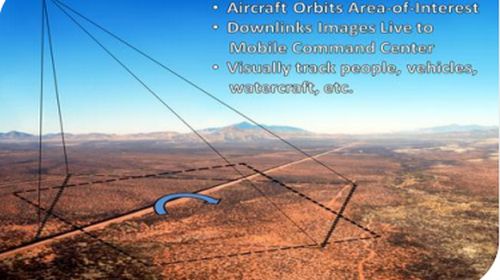
The Washington Post ran a story Thursday on a technology that I’ve been very concerned about for a while: persistent aerial surveillance. Specifically, it profiled a company, Persistent Surveillance Solutions, that has been deploying this panoptic video technology over American cities, as well as in Mexico.
This technology first came to our attention when we got reports from activists in Dayton, Ohio, that the police there had tested it. Some months later, I came across the president of the company, Ross McNutt, giving a demonstration at a drones conference in Orlando. The demonstration was fascinating and compelling, and will no doubt be very persuasive to a lot of people. To me, as a privacy advocate, it was terrifying.
Spying the “ACLU” printed on my badge, McNutt immediately sought to engage with me and followed up with a request for a meeting. A few months later, he was in my office explaining the technology, answering my questions, and pressing his case for why we should not be concerned. Much of what he told me echoed what he apparently told Craig Timberg for the Post’s story, such as the limits on the resolution of his system, and his plans, as camera resolution improves, to use that improvement to increase his coverage area rather than the pixel count of the images collected. (He pointed out that covering a larger area is a square function, requiring exponential increases in capacity.) He also told me:
- The system “can’t tell the difference between a person and a bush sitting in a back yard, unless you move.”
- “We only do major crimes; it’s all we have time for.”
- His signal is updated only one time per second, a frame rate that, while very slow by video standards, “is more than adequate to follow vehicles.”
- The Dayton police chief wants to “bring in at-risk youth in and show them what we can do,” purely for the deterrent effect.
- “We can watch half of Dayton at once.”
- “Of thousands of moving vehicles, we’re interested in just a couple.”
- Though meaningless in the city, “on the border we can do movement detection.”
- He envisions communities being presented with a range of policy options on questions such as data retention, which he compared to the IE browser privacy slider. “My analyst should be trained, subject to oversight and policies, and able to say ‘no’ to the cop sitting next to him.”
I also asked McNutt about the ability to log and store location movements on a mass scale. What he told me is that automated location-trail logging is still very limited. He said the Air Force has been working on it for 10 years, and “is failing with automated tracking.” In contrast, “Ours is a manpower-intensive system” in which analysts manually, visually trace movements from a crime scene. He said their current policy was that they “only start from a reported crime,” and that typically analysts working for his company will “put everything together” overnight, and then present detectives with a detailed incident report.
I give McNutt credit for reaching out to us, for answering my questions seemingly frankly and straightforwardly, and for thinking about the privacy dimensions of what his company does. And some aspects of his service, such as the low resolution and the labor-intensive nature of the analysis, do offer some comfort.
In the end, however, this is not about McNutt or even his company; it’s a much bigger issue that we’re confronting. The fact is, this technology has arrived, and we should not take comfort in the various limitations imposed by current technology (which will be wiped out by time and progress) or by self-restraint on the part of McNutt and his company (which always ends up falling by the wayside, if not by one company than by its competitors). As McNutt himself pointed out to me, “someone is going to do this.”
That is, if we decide to permit it. When I saw McNutt’s presentation in Orlando, I thought to myself, “Here we are, this is where the rubber hits the road.” This technology like nothing else outside the NSA confronts us with the question of whether we want to go (continue) down the path of becoming a “collect it all” society, where everything we do is stored so that the authorities can hit “rewind” on our lives should we for some reason come to their attention.
The Post points out that Americans have become increasingly accepting of video surveillance cameras. But drones have provoked huge opposition and concern across the country, and this technology does exactly what everyone has feared that drones would do—except it uses manned aircraft instead of drones to get around the current legal restrictions on unmanned flight. In a rational world the reaction against drones will translate to a reaction against persistent aerial surveillance in general.

